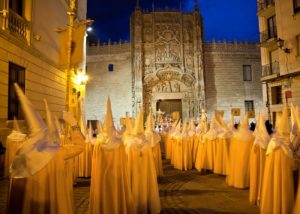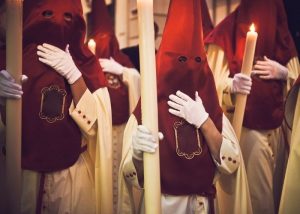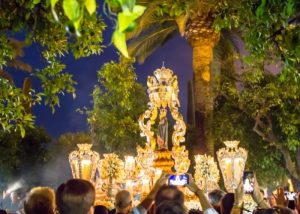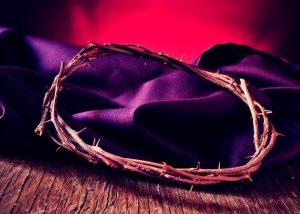SEVILLE – This Palm Sunday or ‘Domingo de Ramos’ is the start of Semana Santa in Spain. Throughout Spain Easter is widely celebrated in a different way than most visitors of Spain know. Watching the Spanish Easter processions is a spectacle in itself, but becomes even more interesting when you know more about the background and its symbolism.
Chaotic and small or impressive and solemn. The Easter processions in Spain leave no sense untouched. Whether you experience them in a small village in the campo or watch the most famous processions in cities like Seville or Málaga, Semana Santa is celebrated differently, but no less lavishly.
What is the start of the new season for the tourism sector is the highlight of the year for masses of Spaniards. Processions are held daily from Palm Sunday to Easter. Each procession begins with an image of the Passion of Christ and ends with an image of the Blessed Virgin.
Also read: Spain can finally celebrate Semana Santa again
Surrounded by penitents, musicians, and thousands of spectators, the stretchers of biblical scenes sway through the incense-filled alleys and streets. Furthermore, mesmerising drum rolls are interspersed with vocal solos that can go to the marrow.
 BROTHERHOODS
BROTHERHOODS
Everything revolves around the brotherhoods during Easter week in Spain. Some brotherhoods (cofradía or Hermandad) are more than five centuries old.
Penance for the Church was at one time the only form of punishment in Catholic society. In times when the Black plague wreaked havoc in Europe, the first penitents organised themselves into these brotherhoods. Moreover, open penance would be the only remedy to stop the wretched disease.
The ‘new faith’
The arrival of the Catholic Monarchs at the end of the fifteenth century resulted in an explosive growth in the number of brotherhoods. After eight centuries of Moorish rule, it was not easy to convert the population to Christianity. Much haste was therefore made in building churches and no effort was spared to imbue society with the ‘new’ faith. For this purpose, the brotherhoods were an excellent instrument.
Although both words ‘cofradía’ and ‘Hermandad’ contain “brother” (frade and hermano), their origin is different. Cofradias are based on different professions and Hermandades united for different reasons.
Members
Now, centuries later, every parish or historic district possesses one or more confraternities, which act as social binding agents and serve to deepen the faith. Consequently, membership is seen as an honour and entitles you to participate in the Easter processions. Members are active within the brotherhood throughout the year. Furthermore, the preparation of the Easter procession is the highlight of the year for them.
Each fraternity must be approved by the Church and the bishop confirms election to the board. Despite this, brotherhoods are not part of the church hierarchy.
 Religious and social motives
Religious and social motives
It is not only religious motives that underlie membership in a brotherhood. Some brothers are atheistic and join for social reasons, for example from family tradition. The older a brother is, the higher its rank. Therefore, the elder brother is automatically president of the brotherhood.
IMAGE WORSHIP
To people from other countries, the seven-day spectacle can come across as strange, disproportionate, and almost too exuberant for a religious memorial celebration. We northerners are usually a bit more modest.
 Realistic
Realistic
The veneration of the suffering Christ and his grieving mother is symbolised by statues that, complete with blood and tears, often look extremely realistic and have been given the most bizarre names: Such as, Our Father Jesus of the Cross Descended into the Mystery of His Holy Shroud or Most Holy Mary of Light in the Mystery of Her Three Needs…
The worship of images is a well-known phenomenon within the Catholic faith. In Spain, after the country was liberated from Islamic rule, some scoops were added.
To convert
The great advantage of depicting and imagining biblical scenes was that the people could thus become more familiar with their content. Therefore, after eight centuries of Moorish rule, the Catholic Church in Spain used this help to convert an entire nation.
And still openly worshiping, openly reviving the mysteries of the Saviour’s passion, death and resurrection, and public penance is the ultimate form of faith. This is most evident during Semana Santa.
THE PROCESSIONS
When the sound of the screeching trumpets and the rhythmic drum roll increases and the first ‘trono’ (portable throne) appears around the corner, many Spaniards feel the emotions. Foreigners are also often completely impressed. Furthermore, a special event like Semana Santa has no equal. All the brothers look forward to the day when their tronos of Christ and the Virgin are lifted through the city.
 Agony
Agony
Each procession depicts a scene from the agony of Christ. From his triumphant entry into Jerusalem through his cloister and his resurrection. Some brotherhoods portray a complete last supper on their thrones.
Intense moments
The church or chapel to which the brotherhood belongs and where the statues are arranged throughout the year is always the starting and finishing point of the procession. Consequently, this is where the most intense moments can be experienced. Therefore, much commotion ensues as soon as the trono takes its first steps outside the chapel.
PENITENTS
At the front of each procession, the leaders of the brotherhoods walk solemnly with the finest art treasures in their hands. The elder brother is in front and carries the ‘Cruz de Guía’ (a large cross).
 ‘Nazarenos’
‘Nazarenos’
This is followed by the wind musicians who have practiced their melancholic sounds all year round on boulevards or in parks. The Nazarenes (penitents) carry large candles or lanterns and are very impressive, especially for foreigners. With their cloaks, cords, and peaks in the colours of their brotherhood, they look stunning. Dozens of figures with long tails, Ku Klux Clan-Esque hats, with only room for eye-level holes.
‘Capataz’
After this whole spectacle has passed at a walking pace, the first throne with Christ follows. The ‘Capataz’ (overseer) walks in front of the Christ statue and directs the bearers in the right direction. With a bell, he gives signals for rest and continuing
 Music and candle holders
Music and candle holders
The older brothers walk closest to the throne. Behind it follow music bands and candle holders. Especially during the moments of rest, it is very interesting to observe the chaotic hassle. Porters talk to family, bottles of water pass from hand to hand, the smallest brothers scurry among each other, pointed hats are taken off and the musicians try each other’s instruments.
MARIA
At the end of the procession, the statue of the Blessed Virgin, adored by many, follows. Whatever form Mary appears in, she is always dressed in the most beautiful robes of expensive fabrics, embroidered with gold and silver thread and surrounded by flowers in colours that symbolise the Passion of Christ, often red carnations and purple irises.
Wash balls
Behind the procession and the virgin, people walk along out of sympathy or gratitude. This is because they have received something from the brotherhood or because their prayers have been answered. In between, children collect as much candle wax as possible to turn it into large coloured balls. The bigger the wash ball, the higher the prestige in their neighbourhood.
 Pointed hats
Pointed hats
The menacing-looking Ku Klux Clan-like pointed hats are called ‘capirote’ and guarantee the anonymity of the participants. Every brotherhood fixes the height of the pointed hat. Thus sacrifices can be made without vanity. Historically, the pointed hats served to guarantee the anonymity of the new Christians, who were not yet appreciated by the masses at the time.
Executioners
Another source refers to the Spanish Inquisition. One text states that religious prisoners were required to wear the cap made of cardboard in the shape of a point as a sign of penance, while it is also claimed that the executioners wore this type of headgear to remain anonymous.
THE STATUES
The statues on their thrones form entire art galleries, decorated with silver and gold and lavishly enriched with flowers, seem to float over the heads of thousands of people through the streets.
 Heavyweight
Heavyweight
The pomp and ceremony on the thrones are not without weight. In one village the ‘costaleros’ (carriers) walk invisibly under the portable and in other locations, you can see how the men experience their war of attrition for hours and carry their heavy burden with them. Some ‘tronos’ weigh more than 3,000 kilos.
In Málaga, you can often find more than 200 men among the enormous monstrosities. Heavy for the physical frame, but a great honour for the mind. Some fraternities even have long waiting lists to carry the throne. A single carrier is blindfolded and in this way sacrifices for, for example, a sick family member.
Saetas
Often, when the statues pass, ‘saetas’ well up spontaneously. Beautiful dramatic songs about the Passion are based on flamenco music, which the singers spontaneously pour out over the throne and their carriers from a window or balcony.
Sometimes two thrones of competing brotherhoods meet. Subsequently, this can lead to a showdown where the costaleros try to lift their throne as high above their shoulders as possible. Occasionally, the Virgin, excited by the olé shouting from the audience, suddenly starts to ‘dance’.
 Practical
Practical
In 2022, Domingo de Ramos (Palm Sunday) falls on April 10. From then on there are processions until Easter Sunday on April 17.
More about Semana Santa in Seville, the parades in Málaga, Córdoba, Alicante, Valencia, Madrid, and Barcelona. Keep an eye on the regional and local newspapers for precise schedules. They usually publish extra sections about Easter week both before and during Semana Santa.


